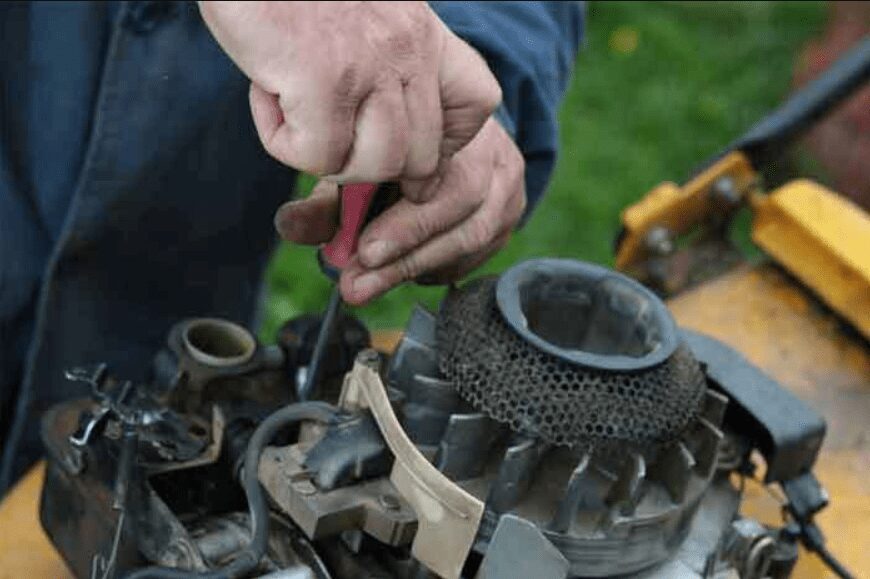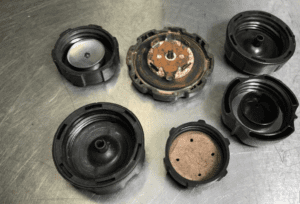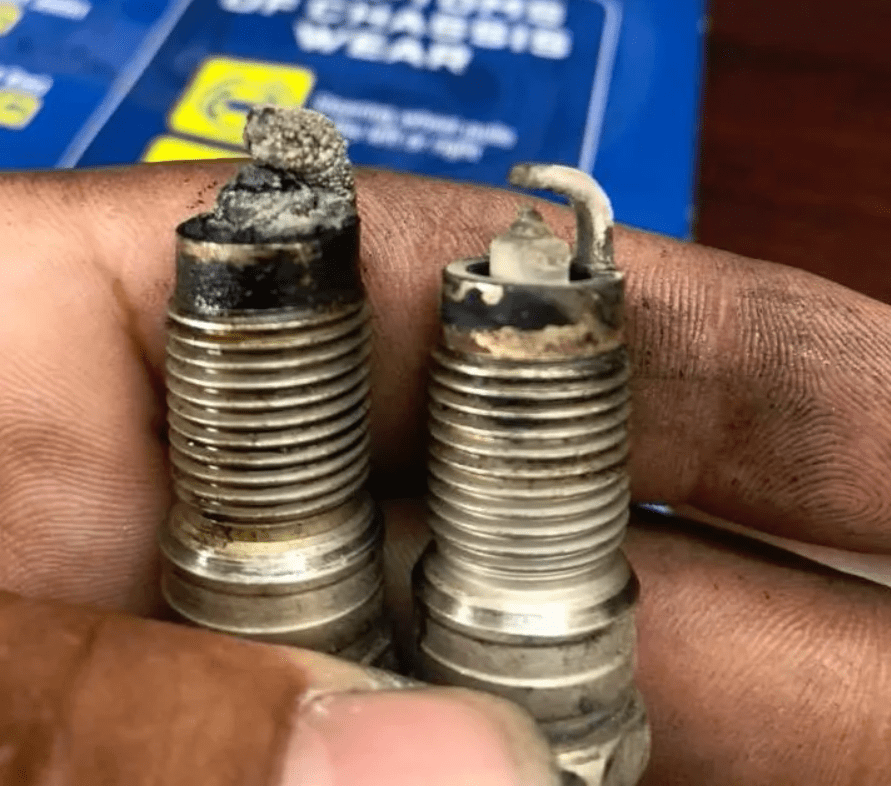
It’s a common problem your lawnmower starts fine, but after a few minutes of operation, it stops running. What gives? why a Lawnmower starts and then die? Here are the most common causes of a lawnmower that won’t start. If you’re having trouble starting your lawnmower, you may be able to solve the problem yourself. But you can find out what the problem is in this article.
Reasons why lawnmower starts and then die
There are a lot of things that can cause your lawnmower to not start. You might think that your lawnmower is faulty, but there are many other things that could be causing it to not start. some of them are
1. Blocked Gasoline Cap
Blocked gas caps are the most common cause of a lawnmower that won’t start. This is usually a small, flat object that can’t be seen by the naked eye. You can’t hear it either. You just see the mower start, and then the mower stops running. But you know it’s a gas cap because you can smell the gasoline when you take the cap off.
The good news is that you can fix this problem yourself. You can remove the cap, remove the clog, and replace the cap.

How to Fix a Blocked Gas Cap
- Turn off the mower and unplug it.
- Remove the spark plug. If the mower has an on/off switch, use it. Otherwise, just pull the spark plug out.
- Remove the gas cap. If the mower has an on/off switch, use it. Otherwise, just pull the gas cap off.
- Remove the gas line. If the mower has an on/off switch, use it.
- Clean the gas cap. The gas cap should be cleaned after every use. Moreover, If you have a gas can, use it. If not, use a brush or a wire brush. If you don’t have a gas can, use a sponge.
2. clogged Spark Plug
A bad spark plug can cause lawnmower starts and then die and run rough and stall out.
You’ve replaced the spark plug and still, the lawnmower won’t start. There are two likely causes of this: The spark plug is bad or the spark plug has been pulled.
- The spark plug is bad.
The spark plug is the tiny cylinder that sends electricity to the starter motor.
To conclude that a spark plug is bad, you’ll need to find a plug with a spark. If you find a spark, the plug is bad. You can also replace the plug with a new one, but you’ll need to ensure that the spark is a direct connection between the plug and the spark.
- The spark plug has been pulled.
If the spark plug has been pulled, it’s possible that it has become loose. You’ll need to check that the plug is tight and that the spark gap is clear.

Cleaning clogged the spark plug
Before you replace the spark plug, you’ll need to clean the plug and the spark gap. The spark gap is the small gap between the plug and the spark. The gap is the part of the plug that is actually in contact with the spark.
You’ll need to use a wire brush to clean the spark gap and the plug. This is a very tedious process. You’ll need to do it a few times to get the plug and spark gap clean.
There are two ways to clean the spark gap.
Method 1: Using a wire brush
- To clean the spark gap, you’ll need to use a wire brush. You can use a 1/8-inch wire brush.
- You’ll need to hold the wire brush so that the gap is in the center of the wire brush.
- Then, you’ll brush the gap and the plug.
- You’ll need to brush the gap and the plug in the same direction.
- If you brush the gap and the plug in the same direction, you’ll be able to remove any dirt that is stuck to the plug.
Method 2: Using a toothbrush
- You can also clean the spark gap using a toothbrush.
- You’ll need to hold the toothbrush so that the gap is in the center of the toothbrush.
- Then, you’ll brush the gap and the plug.
- You’ll need to brush the gap and the plug in the same direction.
- If you brush the gap and the plug in the same direction, you’ll be able to remove any dirt that is stuck to the plug.
The damaged or uncharged battery may cause the plug to spark properly. don’t worry here is a solution to this problem
How long does it take to charge a lawnmower battery?
3. Dirty Carburetor
A carburetor is a small device that helps to mix fuel and air before it enters the engine.
A carburetor that is clogged or has been damaged can cause lawnmowers to start and then die.
To find a carburetor, look for a small metal cylinder attached to the lawnmower’s air intake.
How to clean carburetor?
The carburetor is a very complicated piece of equipment. It contains many parts, and a lot of dirt and debris can accumulate in the various parts of the carburetor. When cleaning the carburetor, it is best to work from the bottom up. This is because dirt and debris tend to collect in the bottom of the carburetor, and the top is where the air enters the carburetor.
Equipment required to clean carburetor:
A good cleaning kit for the carburetor is important. There are many types of cleaning equipment available, and it is important to have the right tools for the job. A good carburetor cleaning kit should contain the following items:
- A spray bottle of carburetor cleaner
- A brush or wire brush
- A sponge or cloth
- An air compressor
- A clean cloth
- A clean rag
- A rubber mallet
- A long-handled brush
- Cleaning Equipment
How to clean carburetor
- Unscrew the top of the carburetor.
- Remove the fuel line and clean the fuel line using a hose and water.
- Clean the air filter.
- Unscrew the screws holding the carburetor.
- Remove the carburetor from the lawnmower.
- Wash the carburetor with a hose and water.
- Replace the carburetor on the lawnmower.
- Replace the fuel line and the air filter.
- Tighten the screws on the carburetor.
4. Excessive oil in lawnmower reservoir:
The reason for this is simple. When the engine is running, it’s using a lot of oil. While the engine is off, the oil drains back into the reservoir. When the engine is running, the oil is used up, so it has to be replaced. The problem is that the reservoir is full of oil when the engine is running. The solution is to add a drain valve to the reservoir.
This valve will be connected to the drain plug. When the drain plug is removed, the drain valve will open, allowing the oil to drain out. When the drain plug is put back in, the drain valve will close.
5. Faulty Choke in lawnmower
A choked choke is a result of a loose or broken choke spring, which causes the carburetor to overheat. A faulty choke can cause lawnmower starts and then die. To check if your choke is faulty, try to start your lawnmower without the choke. If it still won’t start, the choke is probably faulty.
Troubleshooting Faulty Choke
You can also try to adjust the choke yourself. This can be done with the choke in the open position, and the choke key in the first notch. The choke will be at the top of the carburetor.
To adjust the choke, first turn the choke key all the way to the left, to release the choke. Then, turn the key to the right, until the choke is at the desired setting.
6. Ignition System
An ignition system is what helps the spark plug to create a spark that ignites the fuel and air mixture. If the lawnmower’s ignition system is not working properly, the lawnmower may lawnmower starts and then die but will run for only a short time.
To find the ignition system, look for small plastic or metal box attached to the lawnmower’s air intake. Check that the spark is working. If the spark isn’t working, check the coil.
You may have a problem with the ignition system. If the ignition system is bad, you’ll need to replace it.
7. Starter Motor
A bad starter motor can cause a lawnmower to start and stop.
The starter motor is the device that starts the engine. If the starter motor isn’t working, the lawnmower won’t start. To check the starter motor, look for a small motor with two wires coming from it. One of the wires should be connected to the battery. It’s important to check the starter motor. The first thing to do is to turn the starter motor on and off.
Final Thoughts
In conclusion, there are many reasons why a lawnmower might start and then die. To find out what the problem is, it’s important to identify the symptoms and look for clues. Then you can determine whether the cause is mechanical or electrical. the key to solving this problem is to make sure that the spark plug is installed correctly. Make sure there is no Excessive oil in the lawnmower reservoir. The choke works properly.
Frequently Asked Question
There are a lot of things that can cause your lawnmower to not start. You might think that your lawnmower is faulty, but there are many other things that could be causing it to not start. some of them are
Spark Plug
ignition system
Starter Motor
Excessive oil in lawnmower reservoir
Dirty Carburetor
Blocked gas caps
Blocked gas caps are the most common cause of a lawnmower that won’t start. This is usually a small, flat object that can’t be seen by the naked eye. You can’t hear it either. You just see the mower start, and then the mower stops running.
An ignition system is what helps the spark plug to create a spark that ignites the fuel and air mixture. If the lawnmower’s ignition system is not working properly, the lawnmower may not start or may start but will run for only a short time.
No, to conclude that a spark plug is bad, you’ll need to find a plug with a spark. If you find a spark, the plug is bad. You can also replace the plug with a new one, but you’ll need to ensure that the spark is a direct connection between the plug and the spark.
The gas valve is most likely the culprit. You can check this by opening the gas cap and see if the cap has a “spurting” sound. If so, the valve is the problem. You can try to replace the valve or it could be that the gasket around the valve has dried out and is no longer providing a seal. You can try to tighten the valve, or you can replace it.
There are many different reasons why your lawnmower can get wet with gas. It can be because your mower is old and worn out. Or maybe your lawnmower has a faulty ignition system. Or perhaps you have a leaky tank.
Leave a Reply